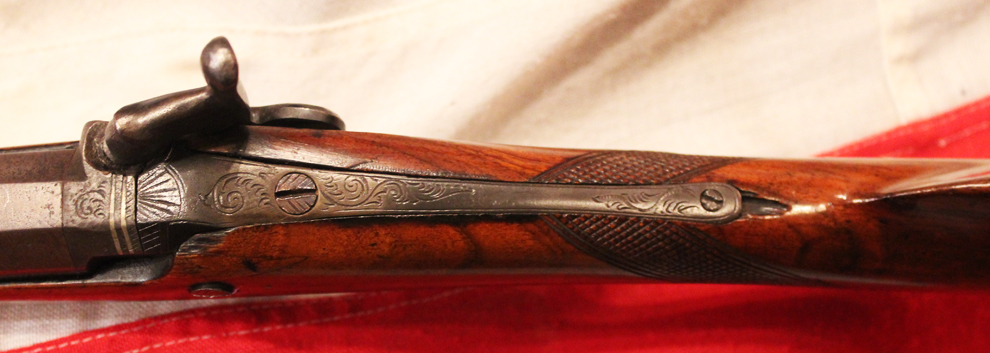A Beautiful 19th Century Damascus Twist Barrelled Sporting Gun By Manton of London. One Of The Greatest Names In the Realm of English Gunsmiths
Back action lock bearing Manton's name and decorative pattern engraving. It has a hook breech with double platinum lining and very attractive fine Damascus browning, walnut half stocked with steel furniture bearing further overall engraving.
Joseph Manton (6 June 1766 - 29 June 1835) was a British gunsmith who innovated in sport shooting, improved the quality of weapons and paved the way to the modern artillery shell. Joseph was also a sports shooter in his own right and a friend of Colonel Peter Hawker. There were two Manton brothers, John was the elder and Joseph the younger. John Manton was born in 1752 and after his apprenticeship, set up in London in Piccadilly.
Manton began producing percussion guns in 1825 and Manton himself died in 1834, leaving the business in the hands of his son. Some of Manton's weapons are considered the finest of the flintlock and percussion age. They can fetch more at auction than Holland & Holland's shotguns. His workforce included James Purdey (who went on to found Purdey's), Thomas Boss, William Greener and Charles Lancaster. These four all went on to establish major firms of gun makers, which continue to this day. The true English Damascus barrel is prepared from three rods, twisted as described and put together as shown in the twisted riband, and is known technically as three-iron Damascus ; the silver-steel Damascus is similarly made, but of different metal piled in a different order. The rods having been twisted, and the required number welded together, they are sent to the iron-mill and rolled at a red heat into ribands, which have both edges bevelled the same way. There are usually two ribands required for each barrel, one riband or strip to form the breech-end, and another, slightly thinner, to form the fore, or muzzle, part of the barrel. Upon receiving the ribands of twisted iron, the welder first proceeds to twist them into a spiral form. This is done upon a machine of simple construction, consisting simply of two iron bars, one fixed and the other loose ; in the latter there is a notch or slot to receive one end of the riband. When inserted, the bar is turned round by a winch-handle. The fixed bar prevents the riband from going round, so that it is bent and twisted over the movable rod like the pieces of leather round a whip-stock. The loose bar is removed, the spiral taken from it, and the same process repeated with another riband. The ribands are usually twisted cold, but the breech-ends, if heavy, have to be brought to a red heat before it is possible to twist them, no cogs being used. When very heavy barrels are required, three ribands are used; one for the breech-end, one for the centre, and one for the muzzle-piece. The ends of the ribands, after being twisted into spirals, are drawn out taper and coiled round with the spiral until the extremity is lost, as shown in the representation of a coiled breech-piece of Damascus iron. The coiled riband is next heated, a steel mandrel inserted in the muzzle end, and the coil is welded by hammering. Three men are required one to hold and turn the coil upon the grooved anvil, and two to strike. The foreman, or the one who holds the coil, has also a small hammer with which he strikes the coil, to show the others in which place to strike. When taken from the fire the coil is first beaten upon an iron plate fixed in the floor, and the end opened upon a swage, or the pene of the anvil, to admit of the mandrel being inserted. When the muzzle or fore-coil has been heated, jumped up, and hammered until thoroughly welded, the breech-end or coil, usually about six inches long, is joined to it. The breech-coil is first welded in the same manner, and a piece is cut out of each coil; the two ribands are welded together and the two coils are joined into one, and form a barrel. The two coils being joined, and all the welds made perfect, the barrels are heated, and the surplus metal removed with a float; the barrels are then hammered until they are black or nearly cold, which finishes the process. This hammering greatly increases the density and tenacity of the metal, and the wear of the barrel depends in a great measure upon its being properly performed. A very nice and tight action and overall in nice condition for age. A very small piece of wood lacking from the breech tang area. As with all our antique guns no license is required as they are all unrestricted antique collectables
Code: 20766
975.00 GBP










